1997 CHEVROLET S10 trailer
[x] Cancel search: trailerPage 58 of 402
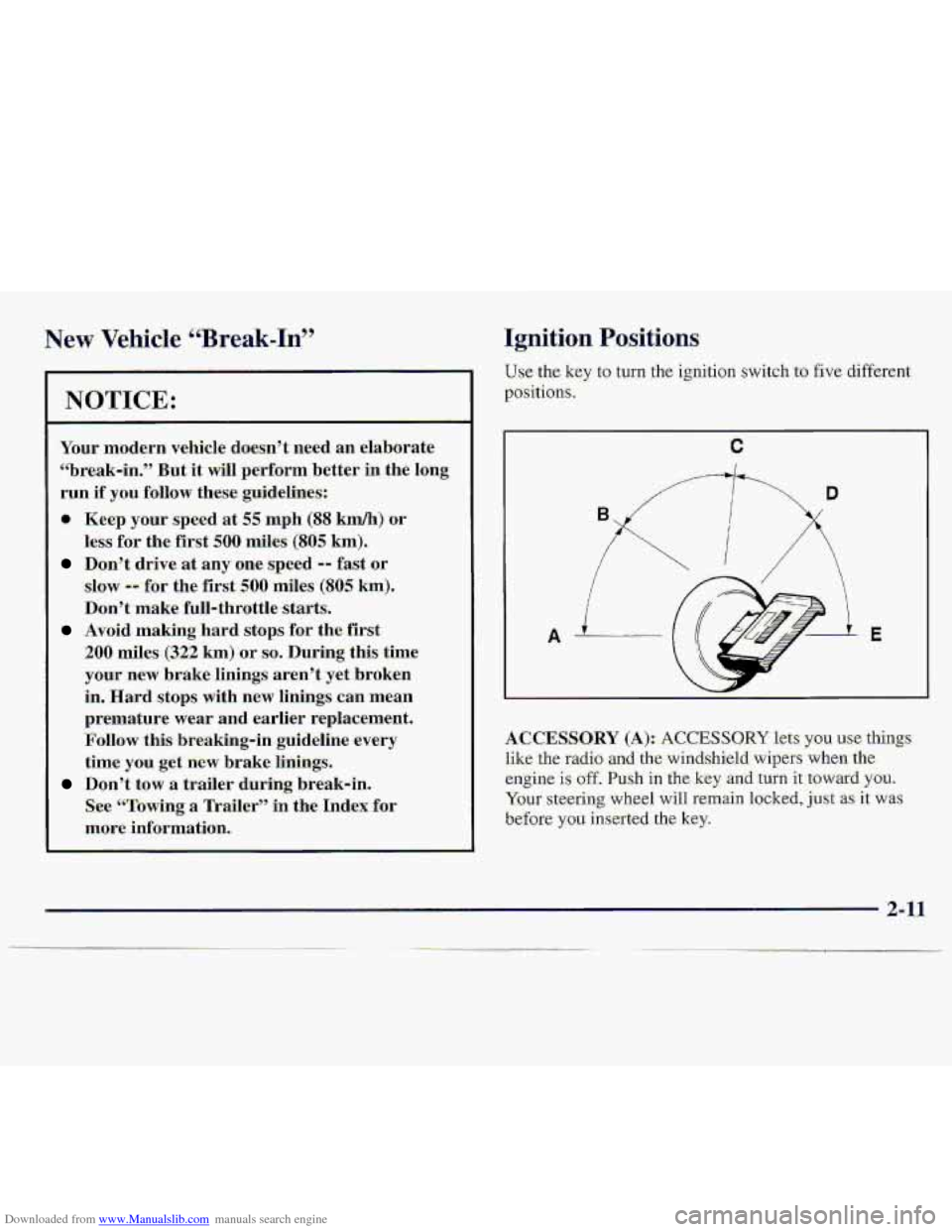
Downloaded from www.Manualslib.com manuals search engine New Vehkk “Bre-ak-In”
NOTICE:
Your modern vehicle d.oesn’t need an elaborate
“break-in.”
But it will perform better in the long
run if you follow these guidelines:
0 Keep your speed at 55 mph (88 km/h) or
less far the first 500 miles (805 km).
Don’t drive at any one speed -- fast or
slow
-- for the first-500 miles (805 km).
Don’t make full-thro.ttle starts.
200 miles. (322 km) or so. During this time
your
new brake linings aren’t yetbro-ken
in. Hard stops with new linings cmmean
premature wear and earlier replacement.
Follow this breaking-in guideline every
time you
get new brake linings.
See “Tbwing a Trailer” in the Index for
more information..
Avoid makiilg hard stops for the first
Don’ttow a trailer during break-in.
Ignition Positions
Use.the key to-turn the ignition switch to €ive different
positions,
A 3.
ACCESSORY (A):. ACCESSO-RY lets ysu .use‘-thi-ngs
like the radio ad the.winds,hield wipe-rs when the
engine is off. Push i.n the key -and turn it toward. YOU.
Your steering wheel will remain locked, just. as it was
before
you inserted the. key.
2-11
Page 64 of 402
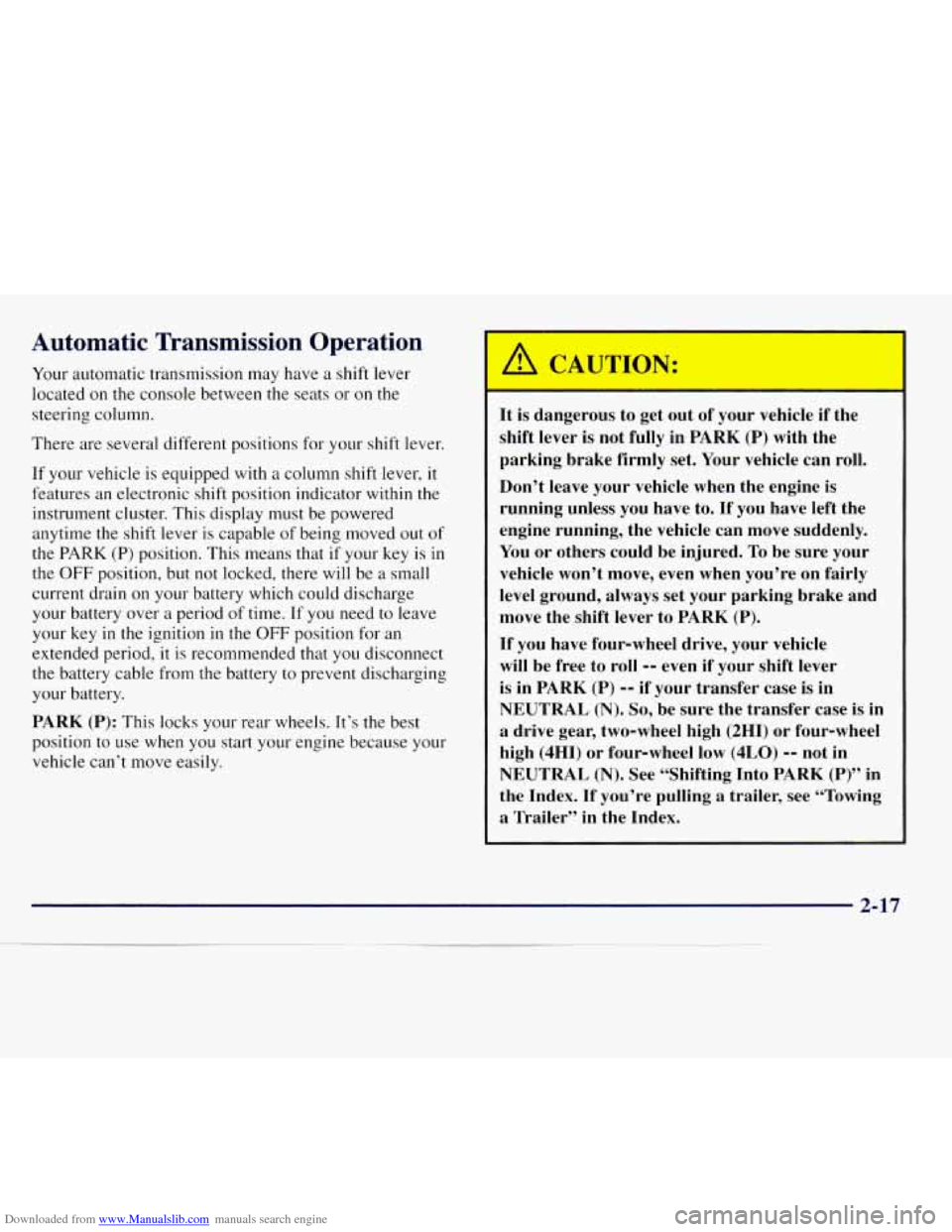
Downloaded from www.Manualslib.com manuals search engine Automatic Transmission Operation
Your automatic transmission may have a shift lever
located
on the console between the seats or on the
steering column.
There are several different positions for your shift lever.
If your vehicle is equipped with a column shift lever,
it
features an electronic shift position indicator within the
instrument cluster. This display must be powered
anytime the shift lever is capable of being moved out
of
the PARK (P) position. This means that if your key is in
the
OFF position, but not locked, there will be a small
current drain
on your battery which could discharge
your battery over a period of time.
If you need to leave
your key in the ignition
in the OFF position for an
extended period, it is recommended that you disconnect
the battery cable from the battery
to prevent discharging
your battery.
PARK (P): This locks your rear wheels. It’s the best
position to use when you start your engine because your
vehicle can’t move easily.
Lf! C A TION:
It is dangerous to get out of your vehicle if the
shift lever is not fully in
PARK (P) with the
parking brake
firmly set. Your vehicle can roll.
Don’t leave your vehicle when the engine is
running unless you have to.
If you have left the
engine running, the vehicle can move suddenly.
You or others could be injured.
To be sure your
vehicle won’t move, even when you’re on fairly
level ground, always set your parking brake and
move the shift lever to
PARK (P).
If you have four-wheel drive, your vehicle
will be free to roll
-- even if your shift lever
is in
PARK (P) -- if your transfer case is in
NEUTRAL (N). So, be sure the transfer case is in
a drive gear, two-wheel high (2HI) or four-wheel
high (4HI) or four-wheel low (4LO)
-- not in
NEUTRAL (N). See “Shifting Into PARK (P)” in
the Index.
If you’re pulling a trailer, see “Towing
a Trailer’’ in the Index.
2-17
Page 66 of 402
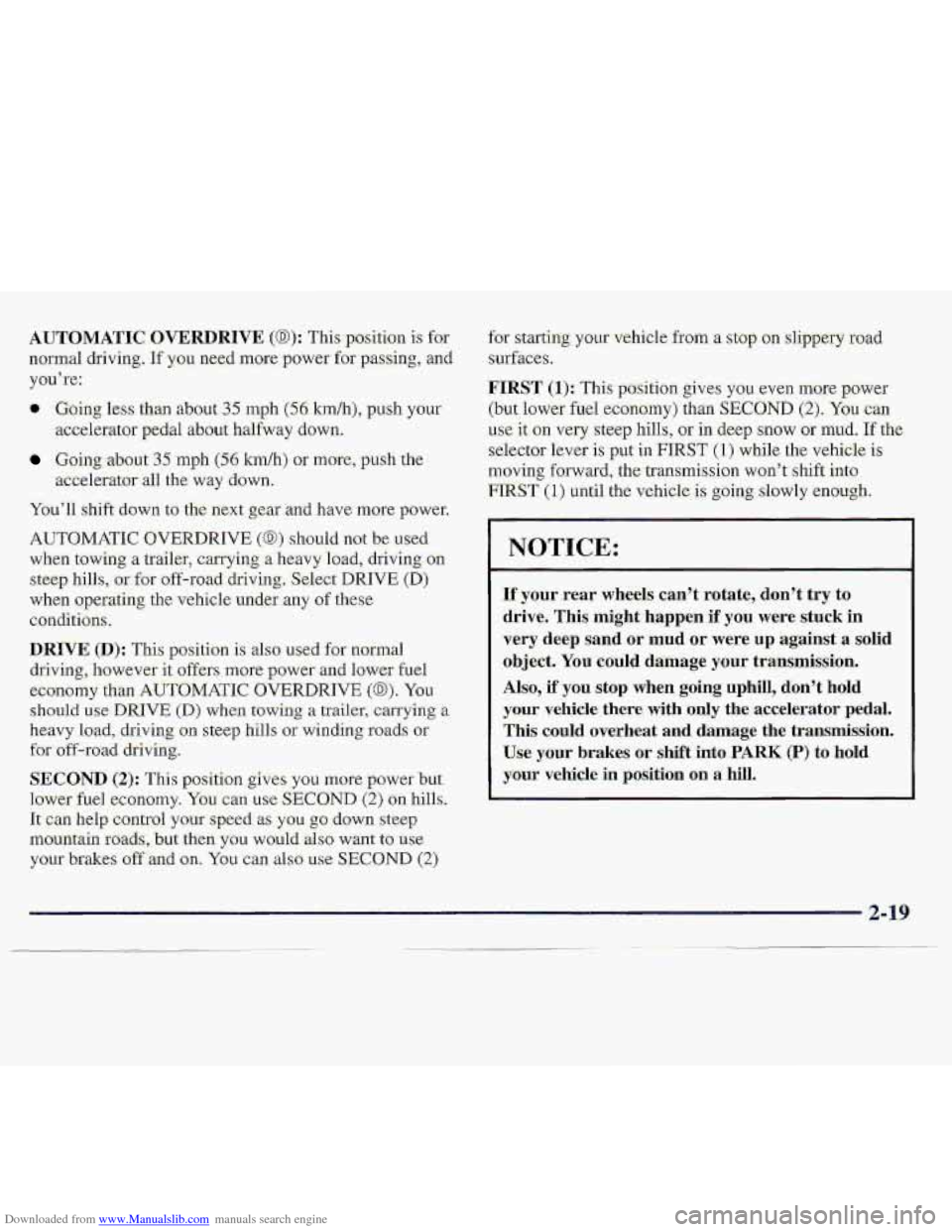
Downloaded from www.Manualslib.com manuals search engine AUT-OMATIC OVERDRIVE (@): This yosition is for
normal driving. If y.ou need more :power for passing, and
yodre:
(r, GQing less than about 35 mpli (56: krnlh), push your
axelerator p:edal about halfway down.
Going< about 35 inph (56 knci/h> or more, push the
accelerator all the way down.
You'-ll shift down to the next gedr and have more power.
AUTOMATIC OVERDRIVE (0) should not b.e used
when towing
a trailer, carrying a heavy load, driving on
steep.
hills, 6r for off-road-driving.. Selecr DRIVE (D)
when operating the vehicle under any of these
conditions.
DRIVE @): This position is also use.d for normal
driving,'however it offers more power -and lower fuel
economy than AUTQMATIC -aVERDRIVE (a). You
should use DRIVE (D) when rowing a trailer; carrying a
heavy load, driving. on steep hills or winding roads or
for .off-road driving.
SEC-OND (2): This position gives. you more power but.
lower fuel economy.' You can use SECOND (2) aji hills.
It can help control your speed as-you go .down steep
mountain
roads., but then you would..also want to use
your brakes off-and on. YOU can ds~ use SECOND (2)
2-19
Page 75 of 402
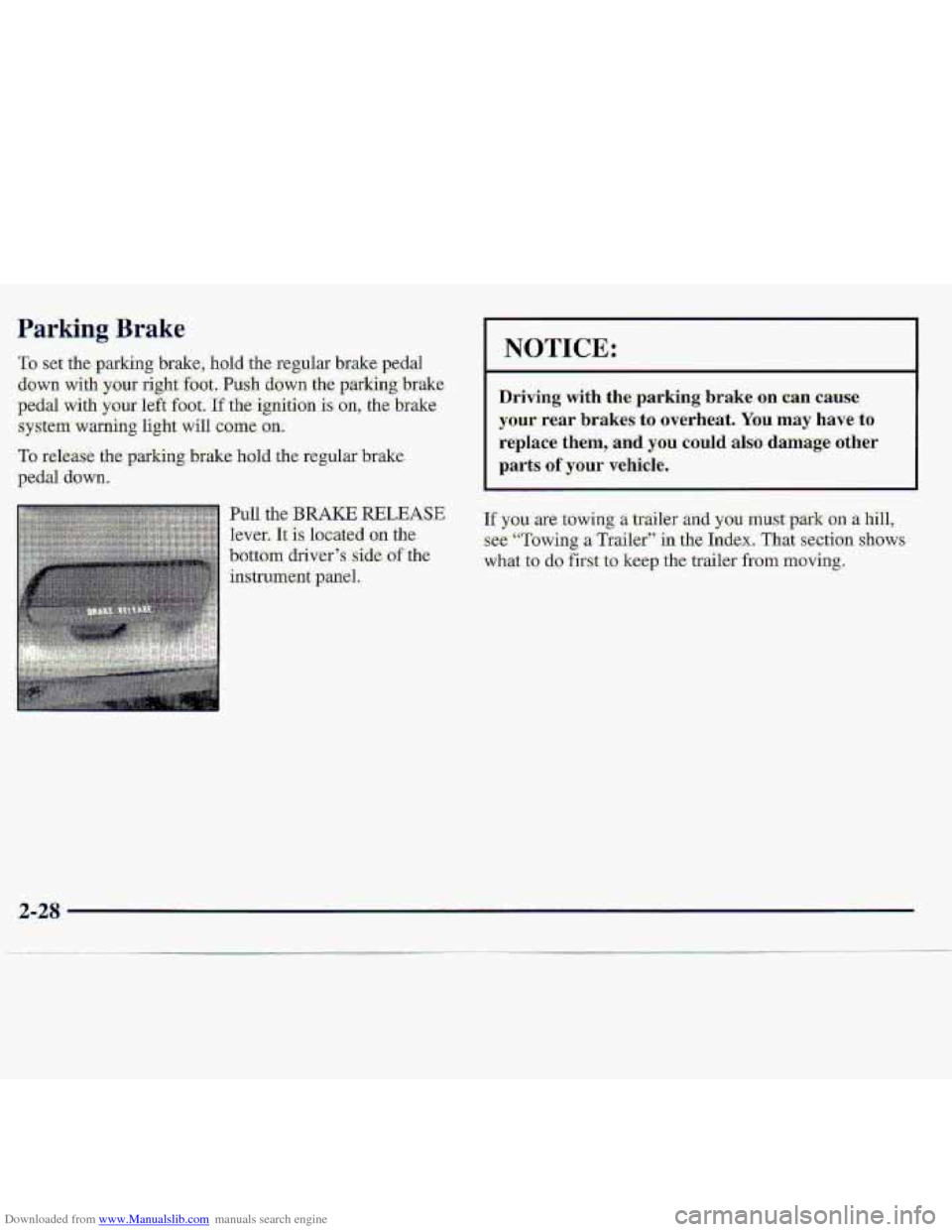
Downloaded from www.Manualslib.com manuals search engine Parking Brake
I NOTICE: I
Driving with .the:p.arking brake on c=an.cause
your- rear brakes to overheat. Y0.u may have to
replace them, and you. could .also-damage other
parts of your vehicle.
If you. are towing a trailer and.you must. park on a hill,
see--"Towing a Trailer" in. the Iadex. That section shows
what to
do first- to. ke.ep the trailer from moving.
Page 76 of 402
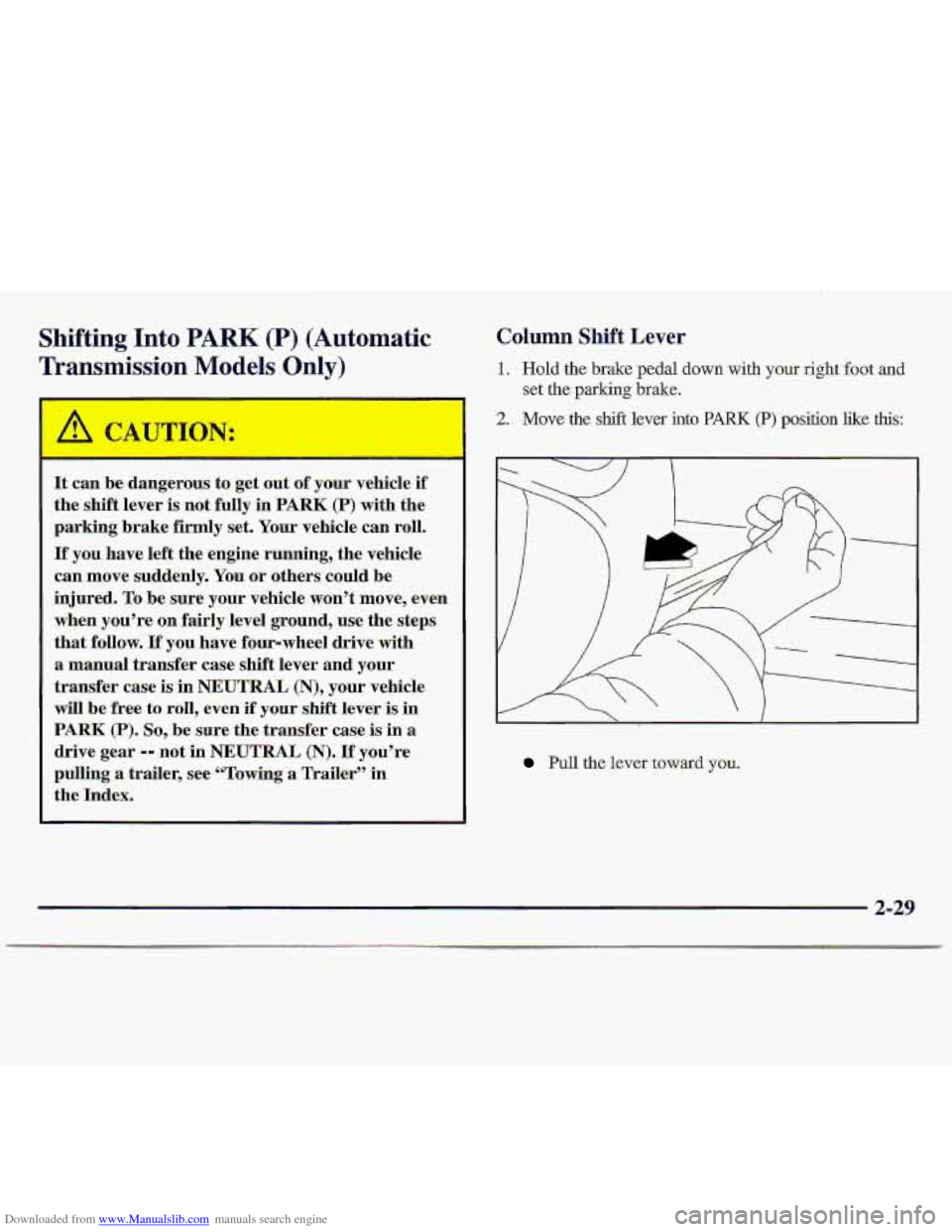
Downloaded from www.Manualslib.com manuals search engine Shifting Into PARK (P) (Automatic
Transmission Models Only)
It can be dangerous to get out of your vehicle if
the shift lever is not fd1y in PARK (P) with the
parking brake firmly set. Your vehicle can roll.
If you have left the engine- running, the vehicle
can move suddenly. You or others could be
injured.
To be sure your vehicle won’t move, even
when you’re on fairly level ground, use the steps
that follow.
If you have four-wheel drive with
a manual transfer case-shift lever and your
transfer case
is in NEUTRAL (N), your vehicle
wiIl be free to roll, even if your shift lever is in
PARK (P). So, b.e sure the trans€er case is in a
drive gear -- not in NEUTRAL (N). If you’re
pulling
a trailer, see CLTowing a Trailer’’ in
the Index.
Column Shift Lever
1. Hold the brake pedal down with your right,foot and
2. Move the SM lever into PARK (P) position like this:
set the parking brake.
1 I
Pull the lever toward you.
2-29
Page 79 of 402
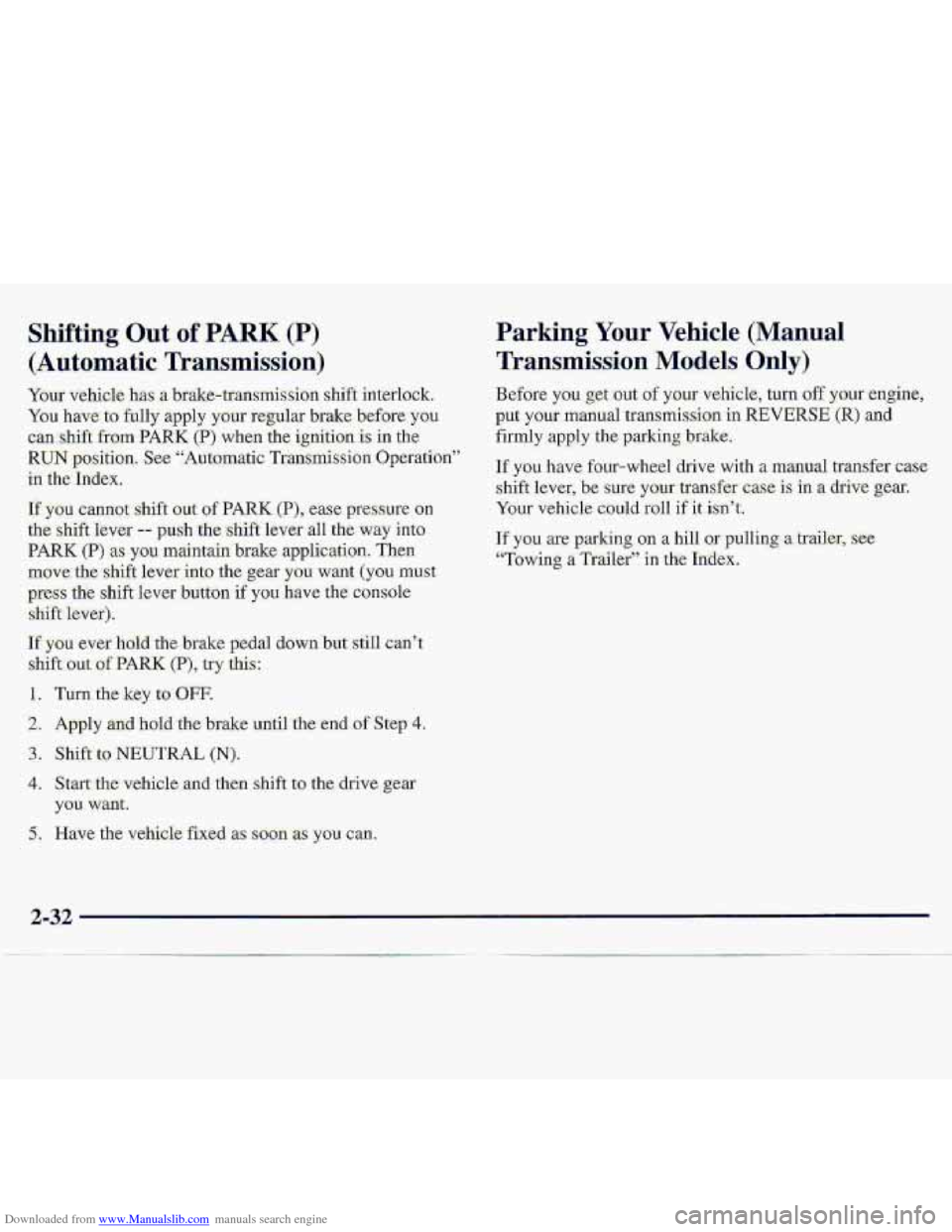
Downloaded from www.Manualslib.com manuals search engine Shifting Out of PARK (.P)
(Automatic Transmission)
Your vehick has a brake-transmission shift biterlock.
You have to fully apply your regular brake before. you
can :.shift from PARK (P) when the i-gnitlon is in the
RUN position. See- “Automatic Transmission Operation”
in the Index,
If you cannot shift out of PARK (P), ease pressure on
the shift lever -- push the shift lever all the way into
PARK (PI as you maintain brake application. Then
move the shift lever into the gear you want (you must
pms the shift lever button if you have the. console
shift lever).
If you ever ho1.d the brake pedal down but still can’t
shift out
of PARK- (P), try this:
Par g, Your Vehicle (M-anual
Transmi,ssion Models Only)
Before you-get out of your vehicle, turn off your engine,
put
y.0~11- manual transmission in REVERSE-(R) and
firmly .apply the parking bzakei
If you have four-wheel drive with a manual transfer case
.shift lever, be sure
your transfer case is in a drive gear.
Your vehic1.e
could roll if it i.sn’t.
If you are parking on a hill or pulling a trailer, see
“Towing a Trailer” in the Index.
I. Turn the key to OFF.
2. Apply and ho-18 the brake until the end of Step 4.
3. Sliiffto NEUTRAL (N).
4. Start. the vehicle and then shift to the drive gear
5. Have the vehide fixed as soon as you can.
you want.
2-32
Page 81 of 402
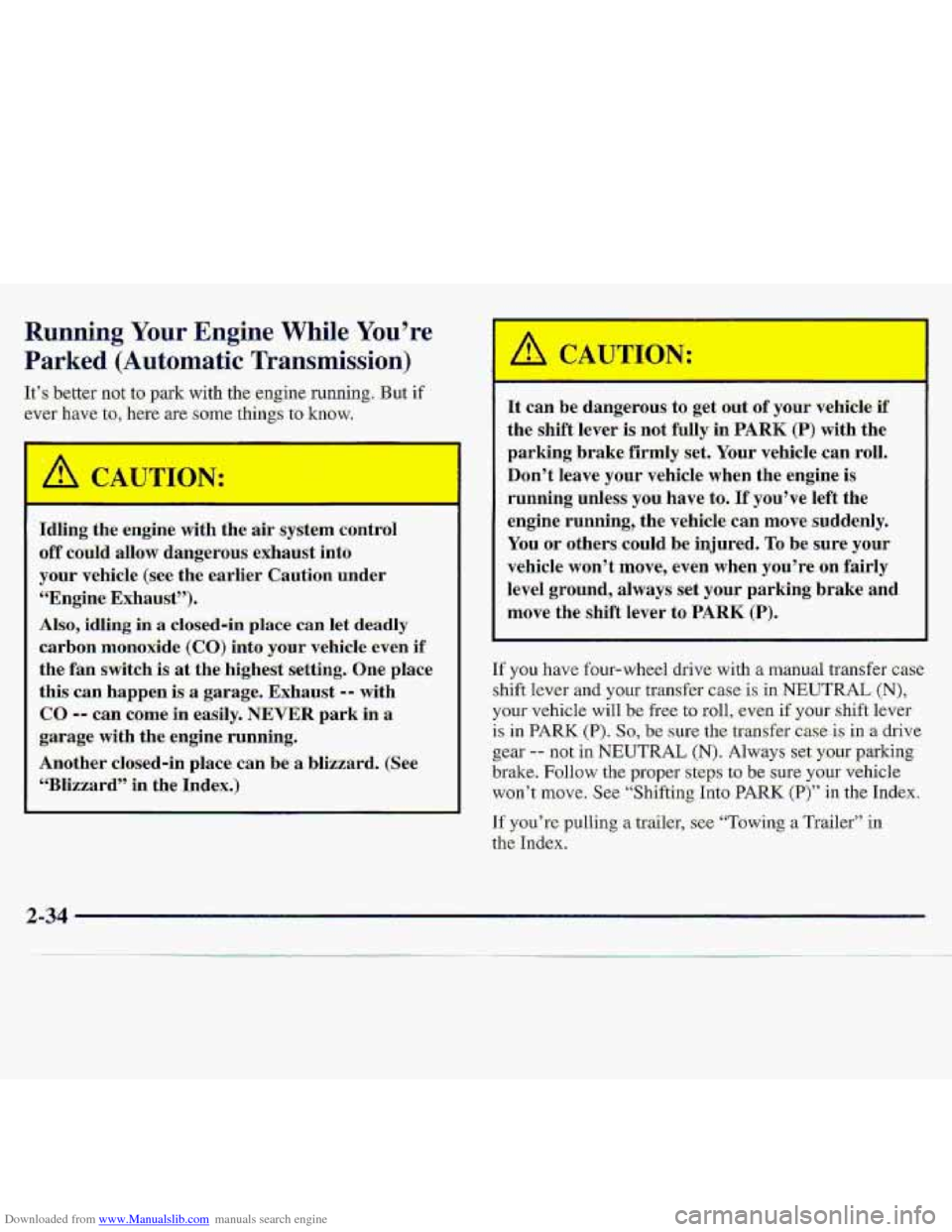
Downloaded from www.Manualslib.com manuals search engine Running, Your Engine While Yo-u’re
Parked (Automatic Tr-ammission)
It’s better not to park with the -.engine running. But if
ever have to, here are some things to knbw.
Idling the engine with L; air system control
off could allow dangerous exhaust into
yom.-vehicle (see the ear1ie.r Caution under
“Engine Exhaust”).
Ab, idiirig-in a. closed-ili place can let deadly
carbon monoxide
(Ca) into y.our vehicle even if
the fen switch is at the highest Setti.ng. One place
this can happen
is a ,garage. Exhaust -- with
CO -- can come in easily. NEVER park in a
,-garage with th-e engine runnihg.
Another cl~sed-in place
can be a. blizzard. (S.ee
“Blizzard” in the Index.)
r
It can be dangerous to get aut.of your vehicle if
the shift lever is not fully in PARK (P) with the
parking brake-firmIy set, Your vehicle c.an roll.
Don’t leave your vehicle when the engine is
running unless you have
to. If you’ve left th.e
engine runnhg, the vehicle can
move suddenly.
You
or others. could be injured. To be sure your
vehicle won’t move, even when you’re bn fairIy
level ground, always set your parking brake -and
move the shift 1-ever-to PARK (P).
If you have four-wheel drivecwith a manual transfer case
shift lever and your tKans-fer case .is in.NErJTRAL. (N),
your v8hicle will be free to roll, even if your shift lever
is in PAR.K (P). So, be sure the tran-sfer c.ase is in a drive
gear
-- not in NEUTRAL (N). Always-set y.our-p.arking
brake.
Follow the proper steps to be sure your vehicle
won’t move. See “Shifting Into PARK.(P)” in the Index.
If you’re pulling a.trailer, see “Towing a Trailer” in
the Index.
2-34
Page 85 of 402
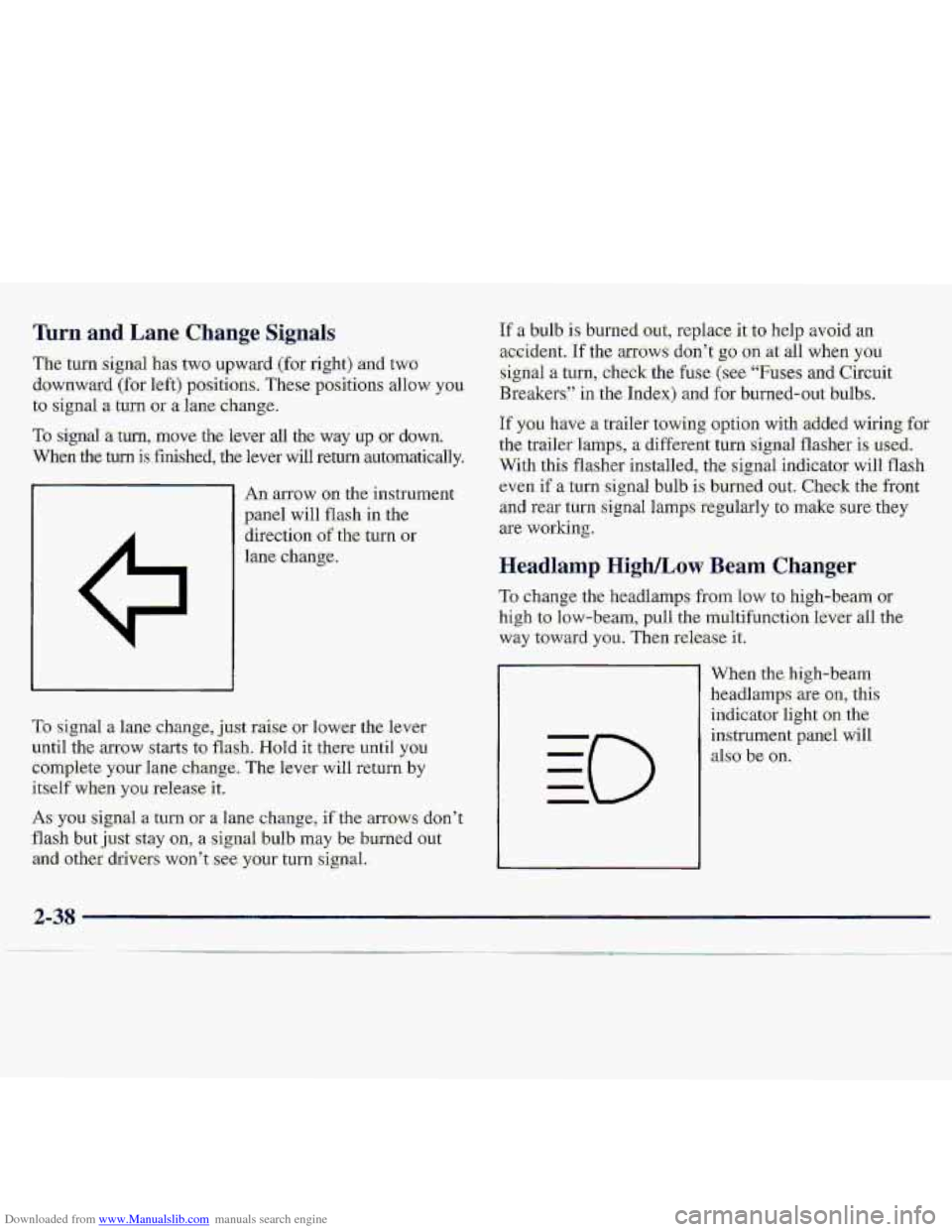
Downloaded from www.Manualslib.com manuals search engine Turn and Lane Change Si,gnak
The turn signal has two upward (fat right) and- two
ciownwa~d
(for left) p??sitions. Tbese positions allow you
to signal a turn 0.r a.lane. change:
To signal -a turn, move the lever all the way up or down.
When the turn is finished, the lever will return aut~omatically.
An anow on. the instrume
panel will flash in the
direction
of the- turn or
lane change.
If a bulb is: burned.out, replace it.t-o help avoid an
acc.ident. If the arfows don’t g.0 on at all when you
sign-a1 a turn, check the fuse (see “Fu-se.s and Circuit
Breakersl’ in the .Ind.ex) and for burned-oat bulbs.
If you have n trailer towing option with -added wiring, for
the. traiier%mps, a d-ifferent turn :signal flasher is used.
With this flashes installed, the signal. indicator will flash
even if a.tum
signal bulb is burllid OW. Check the-ffont
an.d rear turn signal lamps -regularly tu make sure. they
are working.
Headl-amp High/Low Beam Changer
To change the headlamps from low to high-beam or
high to low-beam, pull the multifunction lever all the
way t.oward you. Then release it.
To signa1 a Lane change, j,ust raise- or lower the. lever
until the arrow starts to flash. Hold it there until you
Complete your lane,c,hangc, The kevei- will return by
itself when you release it.
As you signal a turn -or a lane c,hange, if the armws don’t
flash but just sxay on, a signal buIb may be burned Gut
arid other. drivers won’t ,see. your turn signal.. When the.’hi.gh-beam
headlamps are
on,. this
indicator
light .OM the
instrument pgniJ will
dso be on.
..
2-38